What’s the best type of Aquarium Moss your next Aquascaping Adventure?
We’ve got you covered in this Ultimate Aquarium Mosses Guide.
We’ve split the types of moss into Common & Rare varieties due to there availability worldwide. As always, depending on your region, you might find them more or less easily available in your local stores.
We cover 19 different mosses with all the details so you can decide if they’re the right fit to add to your fish tank setup.
Just pick the moss that you love the look of, check out our water parameters and growth tips, then you’re good to go!
We really hope you find this guide helpful, myself and Dan would love to here from you in the comments at the end with your questions or any of your own Moss Growing Tips.
- Related: 12 Best Carpeting Plans
- Related: Best Stem Plants
- Related: Top 16 Aquarium Background Plants
- Related: Top 10 Aquarium Foreground Plants
A Note from Charlie: We’ve snook a few non-mosses into this roundup. They still offer the same great nano-aquascaping potential, but don’t truly belong to the moss family, even if they do look like just like moss…
If you’re absolutely in love with the idea of adding moss to you aquarium, you can skip right over the next section and get to picking out your favourite moss.
16 Different Types of Moss + 2 Bonus Plants
Table of Contents
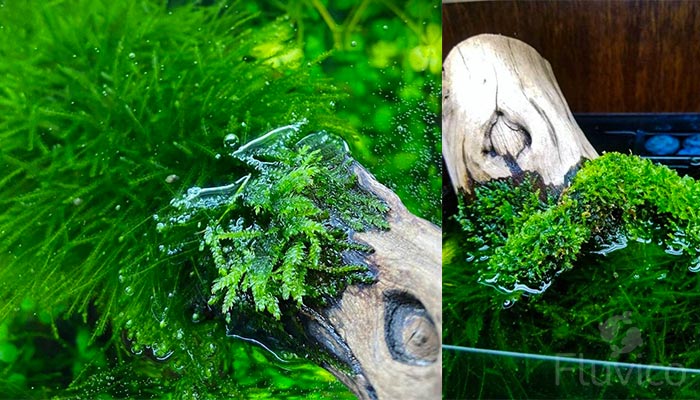
1. Java Moss – Taxiphyllum barbieri
Arguably one of the most popular aquarium mosses, adored for its easy care and versatility in the tank. It’s an excellent choice for beginners who want to start a planted tank.
It can cover virtually any surface it attaches to and provides a vibrant, green backdrop or carpeting in your tank. Java Moss is also highly beneficial to a tank’s ecosystem, offering shelter for smaller creatures and helping improve water quality.
Full Care Guide: Java Moss
- Size: Grows up to 4 inches tall.
- Growth Speed: Fast.
- Light Levels Needed: Low to moderate.
- Ideal Water Parameters: pH 5.0 – 8.0; temperature 15°C to 30°C (59°F – 86°F).
- Difficulty Level: Easy.
- Propagation: Through division.
- Origins: Southeast Asia.
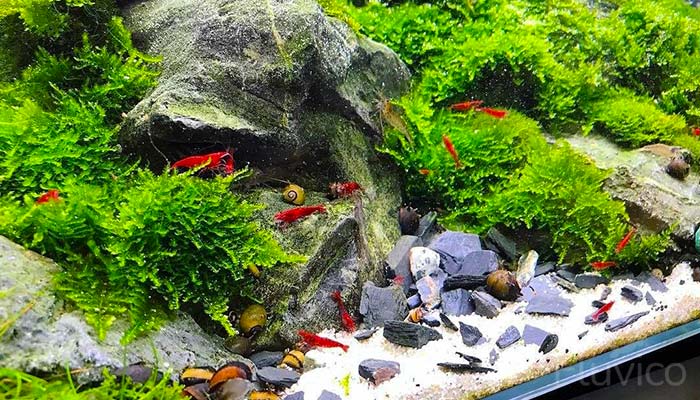
2. Christmas Moss – Vesicularia montagnei
A crowd favourite in the realm of aquascaping, Christmas Moss is revered for its lush, forest-like appeal, resembling the shape of a Christmas tree. It can survive in a wide range of conditions, making it an easy and beautiful addition to your aquarium.
It sets itself apart with its unique growth pattern. When affixed to a surface, Christmas Moss grows in an intriguing triangular pattern, giving it that desirable Christmas tree look.
Full Care Guide: Christmas Moss
- Size: Grows up to 3 inches tall.
- Growth Speed: Moderate.
- Light Levels Needed: Low to moderate.
- Ideal Water Parameters: pH 5.0 – 7.5; temperature 22°C to 28°C (72°F – 82°F).
- Difficulty Level: Easy.
- CO2 and Fertilization Requirements: Not required, but can enhance growth.
- Propagation: Through division.
- Origins: Southeast Asia.
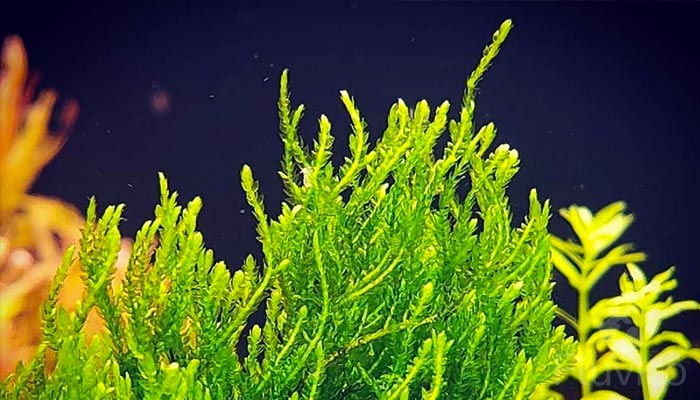
3. Flame Moss – Taxiphyllum sp. “Flame”
Named for its unique upward growth pattern, which mimics the appearance of flames. This moss is particularly attractive to aquarists seeking vertical accents in their aquascape.
It’s the “flaming” appearance that makes it unique. As it grows upwards, the fronds twist slightly, creating the illusion of a flickering flame.
Full Care Guide: Flame Moss
- Size: Grows up to 4-6 inches tall.
- Growth Speed: Slow.
- Light Levels Needed: Low to moderate.
- Ideal Water Parameters: pH 5.0 – 7.5; temperature 20°C to 28°C (68°F – 82°F).
- Difficulty Level: Easy.
- CO2 and Fertilization Requirements: Not required, but can boost growth.
- Propagation: Through division.
- Origins: Asia
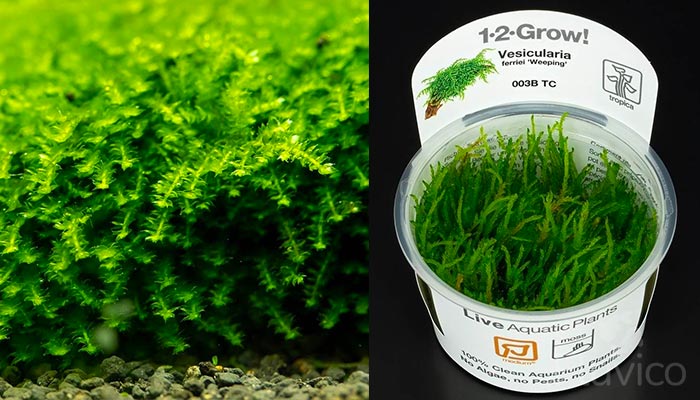
4. Weeping Moss – Vesicularia ferriei
With its elegant cascading growth pattern, adds a touch of whimsy to any aquarium. It’s relatively hardy, making it a good fit for a variety of water conditions.
What’s particularly captivating about Weeping Moss is its drooping growth form, which can create a “weeping” effect, perfect for adding depth and intrigue to your aquascape.
Full Care Guide: Weeping Moss
- Size: Grows up to 3 inches tall.
- Growth Speed: Moderate.
- Light Levels Needed: Moderate.
- Ideal Water Parameters: pH 5.5 – 7.5; temperature 24°C to 28°C (75°F – 82°F).
- Difficulty Level: Intermediate.
- CO2 and Fertilization Requirements: Beneficial, but not necessary.
- Propagation: Through division.
- Origins: China
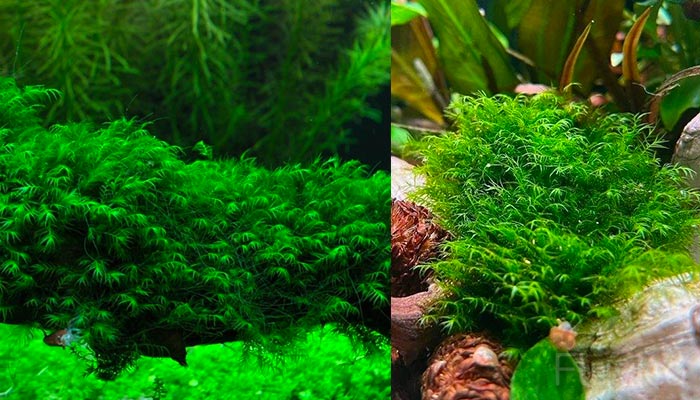
5. Phoenix Moss – Fissidens fontanus
Also known as American Water Pocket Moss, Phoenix Moss it adds texture and interest to any aquarium setup. It has fine, delicate fronds that provide shelter for small fish and invertebrates.
It takes its name from the way its fronds reach upwards, similar to a phoenix rising. It is less commonly seen in home aquariums, making it a unique choice for aquascapers.
Full Care Guide: Phoenix Moss
- Size: Grows up to 4 inches tall.
- Growth Speed: Slow to moderate.
- Light Levels Needed: Low to moderate.
- Ideal Water Parameters: pH 5.0 – 7.0; temperature 20°C to 30°C (68°F – 86°F).
- Difficulty Level: Intermediate.
- CO2 and Fertilization Requirements: Can enhance growth, but not necessary.
- Propagation: Through division.
- Origins: North America.
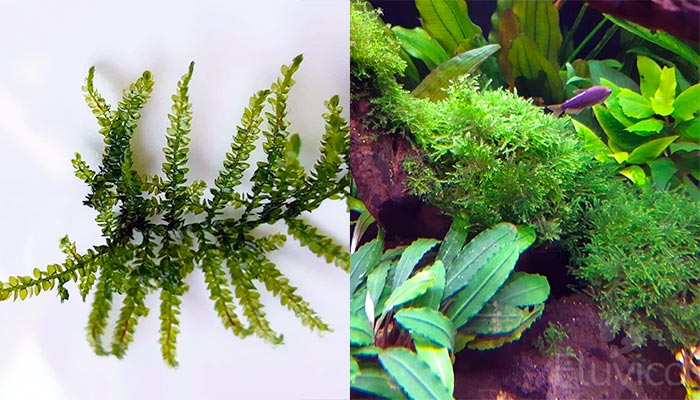
6. Peacock Moss – Taxiphyllum sp.
Named for its fronds that fan out like a peacock’s tail, Peacock Moss is a beautiful addition to any aquarium. It has thicker, fluffier fronds than Java Moss, which provides excellent cover for smaller aquatic creatures.
It’s common for us too hear that Peacock & Spiky Moss are the same type of Moss. And while very similar, Peacock Moss tendrils do grow a little shorter and thicker than the ‘Spiky Moss’ below.
Also, Peackcock Moss & Peacock Fern are often mixed up, with the latter not able to grow submersed or submerged, while being very beautiful in it’s own rights.
The vibrant green of Peacock Moss, coupled with its unique growth pattern, make it a visually striking choice for your aquarium.
Full Care Guide: Peacock Moss
- Size: Grows up to 2-3 inches tall.
- Growth Speed: Moderate to Fast.
- Light Levels Needed: Low to moderate.
- Ideal Water Parameters: pH 5.5 – 7.5; temperature 20°C to 28°C (68°F – 82°F).
- Difficulty Level: Easy.
- CO2 and Fertilization Requirements: Can boost growth, but not necessary.
- Propagation: Through division.
- Origins: Asia.
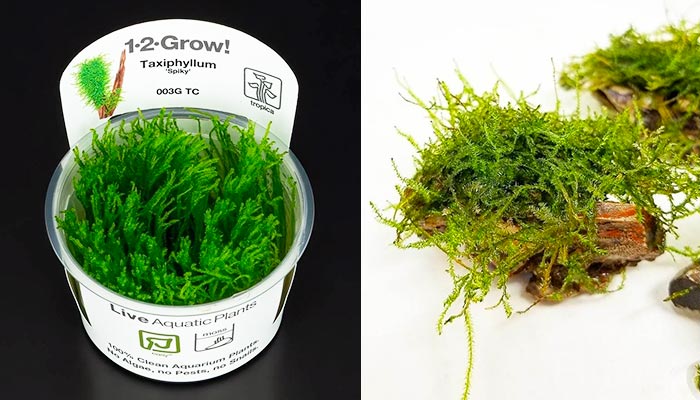
7. Spiky Moss – Taxiphyllum sp. ‘Spiky’
A hardy and fast-growing variant of the Taxiphyllum genus, brings a unique, dense texture to any aquarium. Its longer, spikier shoots make it a better choice for filling a larger area than the Peacock Moss above. It’s also great for a dense carpet or tree-like underwater design.
It’s especially notable for its fast growth rate and ability to fill in spaces quickly, making it a perfect choice for anyone seeking a low-maintenance moss with high impact.
Full Care Guide: Spiky Moss
- Size: Grows up to 4 inches tall.
- Growth Speed: Fast.
- Light Levels Needed: Moderate.
- Ideal Water Parameters: pH 5.0 – 7.5; temperature 20°C to 28°C (68°F – 82°F).
- Difficulty Level: Easy.
- CO2 and Fertilization Requirements: Not necessary but can enhance growth.
- Propagation: Through division.
- Origins: Asia.
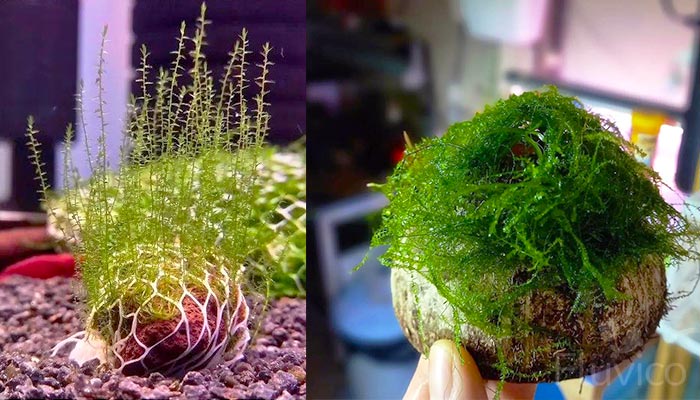
8. Stringy Moss – Leptodictyum riparium
As the name suggests, Stringy Moss grows in long, thin, string-like fronds. It’s an excellent choice for aquarists looking to add length and movement to their setup.
The unruly, free-form growth provides excellent contrast to more structured plants and mosses in an aquascape.
Full Care Guide: Stringy Moss
- Size: Length of strands can reach up to 10 inches.
- Growth Speed: Moderate to fast.
- Light Levels Needed: Moderate to high.
- Ideal Water Parameters: pH 6.0 – 7.5; temperature 10°C to 26°C (50°F – 79°F).
- Difficulty Level: Easy.
- CO2 and Fertilization Requirements: Can enhance growth, but not necessary.
- Propagation: Through division.
- Origins: North America.
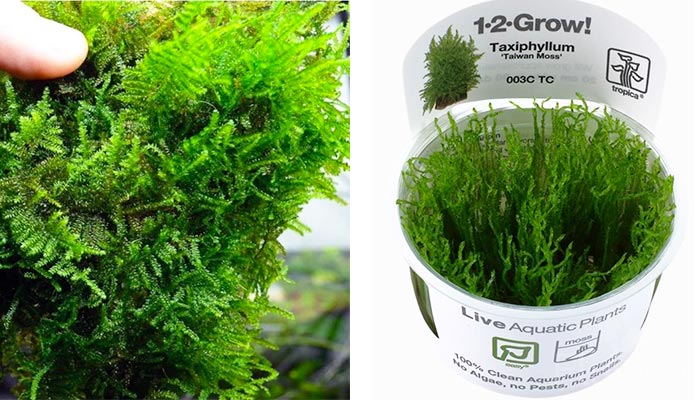
9. Taiwan Moss – Taxiphyllum alternans
A close relative of the popular Java Moss, is an excellent choice for aquarists looking for a lush, dense carpet of green in their aquarium. Its distinctive appearance makes it an ideal accent in any aquascape.
Its fronds are wider and flatter than those of the Java Moss, giving it a more leaf-like appearance. When viewed from afar it resembles a miniature, underwater dense forest.
Full Care Guide: Taiwan Moss
- Size: Grows up to 4 inches tall.
- Growth Speed: Moderate.
- Light Levels Needed: Low to moderate.
- Ideal Water Parameters: pH 5.0 – 7.5; temperature 20°C to 28°C (68°F – 82°F).
- Difficulty Level: Easy.
- CO2 and Fertilization Requirements: Not necessary but can boost growth.
- Propagation: Through division.
- Origins: Taiwan.
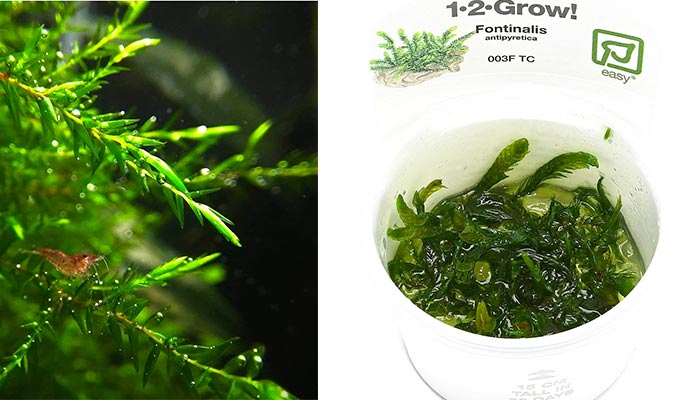
10. Willow Moss – Fontinalis antipyretica
Named for its resemblance to the drooping branches of a willow tree, is a hardy plant that adds a touch of graceful beauty to any aquarium setup. It thrives in a variety of conditions, making it a versatile choice for any aquascape.
The leaves are slender and cascade down, resembling the iconic look of a weeping willow tree. This distinctive growth pattern creates an enchanting underwater scenery.
- Size: Grows up to 6 inches tall.
- Growth Speed: Moderate.
- Light Levels Needed: Low to moderate.
- Ideal Water Parameters: pH 5.5 – 7.5; temperature 10°C to 26°C (50°F – 79°F).
- Difficulty Level: Easy.
- CO2 and Fertilization Requirements: Not necessary but can boost growth.
- Propagation: Through division.
- Origins: Global.
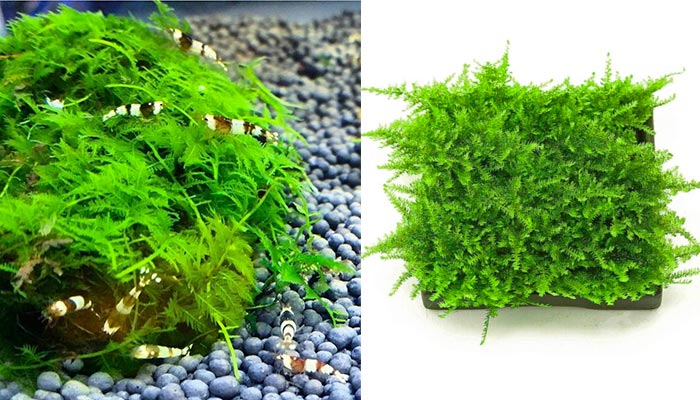
11. Mini Christmass Moss – Vesicularia sp. ‘Mini Christmas’
As the name suggests, Mini Christmass Moss is a small-scale moss that’s ideal for nano tanks or detailed aquascapes. Its delicate, dense growth brings a refined touch to your setup, creating the impression of a mini forest when used in larger quantities.
It’s as sturdy as it is attractive, making it a versatile choice for any aquarist looking for a low-maintenance plant with high aesthetic appeal.
- Size: Grows up to 1 inch tall.
- Growth Speed: Moderate.
- Light Levels Needed: Low to moderate.
- Ideal Water Parameters: pH 5.5 – 7.5; temperature 20°C to 28°C (68°F – 82°F).
- Difficulty Level: Easy.
- CO2 and Fertilization Requirements: Not necessary but can boost growth.
- Propagation: Through division.
- Origins: Southeast Asia.
12 .Mini Taiwan Moss – Isopterygium sp.
(Rare Moss)
Mini Taiwan Moss, as its name implies, is a small variant of the widely popular Taiwan Moss. It’s particularly appealing in nano tanks or areas of your aquarium where space is limited.
It has a dense growth pattern and tiny leaf structure, making it an excellent option for adding fine texture to your aquascape.
- Size: Grows up to 2 inches tall.
- Growth Speed: Moderate.
- Light Levels Needed: Low to moderate.
- Ideal Water Parameters: pH 5.5 – 7.5; temperature 20°C to 28°C (68°F – 82°F).
- Difficulty Level: Easy.
- CO2 and Fertilization Requirements: Not necessary but can enhance growth.
- Propagation: Through division.
- Origins: Taiwan.
13. Floating Crystalwort – Riccia fluitans
(Rare Moss)
Floating Crystalwort, or simply Riccia, is a unique moss option for your aquarium. It is a floating moss, providing an excellent cover for the top of your tank, or it can be anchored down to create a lush carpet.
It’s known for its intense bright green colour and its unique growth pattern, making it a visually striking addition to any tank setup.
- Size: Grows up to 1 inch tall.
- Growth Speed: Fast.
- Light Levels Needed: High.
- Ideal Water Parameters: pH 6.0 – 7.5; temperature 15°C to 30°C (59°F – 86°F).
- Difficulty Level: Intermediate.
- CO2 and Fertilization Requirements: Benefits significantly from CO2 injection and regular fertilization.
- Propagation: Through division.
- Origins: Global.
14. Süsswassertang – Lomariopsis lineata (A Seaweed in Moss Clothing)
(Rare Moss)
Süsswassertang, also known as Freshwater Seaweed, is not technically a moss but is often treated as such in aquascaping due to its similar growth habits. It forms dense, irregular clumps that provide excellent cover and breeding grounds for shrimp and small fish.
Süsswassertang has a soft, fern-like texture, which can create a striking contrast in a moss-dominant tank.
- Size: Grows up to 3 inches tall.
- Growth Speed: Slow to moderate.
- Light Levels Needed: Low to moderate.
- Ideal Water Parameters: pH 5.5 – 7.5; temperature 20°C to 28°C (68°F – 82°F).
- Difficulty Level: Easy.
- CO2 and Fertilization Requirements: Not necessary but can enhance growth.
- Propagation: Through division.
- Origins: Southeast Asia.
15. Riccardia chamedryfolia – Riccardia chamedryfolia
(Rare Moss)
Riccardia chamedryfolia, also known as Mini Pellia, is a small liverwort that is commonly used in aquascaping. Its dark green, intricate fronds offer an elegant and unique texture.
This mini liverwort grows very slowly and requires a bit more care than your typical moss, but its enchanting, miniature landscape is worth the extra effort.
- Size: Grows up to 1 inch tall.
- Growth Speed: Slow.
- Light Levels Needed: Moderate to high.
- Ideal Water Parameters: pH 5.5 – 7.5; temperature 20°C to 26°C (68°F – 79°F).
- Difficulty Level: Intermediate to advanced.
- CO2 and Fertilization Requirements: Prefers CO2 and regular fertilization.
- Propagation: Through division.
- Origins: Global.
16. Cameroon Moss – Plagiochilaceae sp.
(Rare Moss)
Cameroon Moss is a rare and exciting moss to include in your aquarium. It has a unique, compact growth form and looks like a miniature pine tree under water.
It’s particularly attractive if you want something a bit different from the usual moss choices. Despite its rare status, it’s as hardy as it is beautiful.
- Size: Grows up to 4 inches tall.
- Growth Speed: Slow to moderate.
- Light Levels Needed: Low to moderate.
- Ideal Water Parameters: pH 5.0 – 7.0; temperature 22°C to 28°C (72°F – 82°F).
- Difficulty Level: Easy.
- CO2 and Fertilization Requirements: Not necessary but can boost growth.
- Propagation: Through division.
- Origins: Africa.
17. Coral Moss – Riccardia graeffei
(Rare Moss)
Coral Moss, or Mini Coral Moss, is an uncommon moss that offers a distinctive texture to your aquascape. Its appearance is reminiscent of corals, thus the name.
It’s a slow-growing, densely branching species that forms an intricate mat of bright green, ideal for accentuating driftwood or as a carpet plant.
- Size: Grows up to 1 inch tall.
- Growth Speed: Slow.
- Light Levels Needed: Moderate to high.
- Ideal Water Parameters: pH 5.5 – 7.5; temperature 20°C to 28°C (68°F – 82°F).
- Difficulty Level: Intermediate.
- CO2 and Fertilization Requirements: Prefers CO2 and regular fertilization.
- Propagation: Through division.
- Origins: Southeast Asia.
18. Erect Moss – Vesicularia reticulata
(Rare Moss)
Erect Moss stands out from the crowd with its unique, upright growth pattern. It forms thick clusters of upright stems, creating a forest-like impression.
It’s easy to grow and can create a dramatic effect in your tank, especially when used to create a vertical element in your aquascape.
- Size: Grows up to 3 inches tall.
- Growth Speed: Moderate.
- Light Levels Needed: Low to moderate.
- Ideal Water Parameters: pH 6.0 – 7.5; temperature 20°C to 28°C (68°F – 82°F).
- Difficulty Level: Easy.
- CO2 and Fertilization Requirements: Not necessary but can enhance growth.
- Propagation: Through division.
- Origins: Southeast Asia.
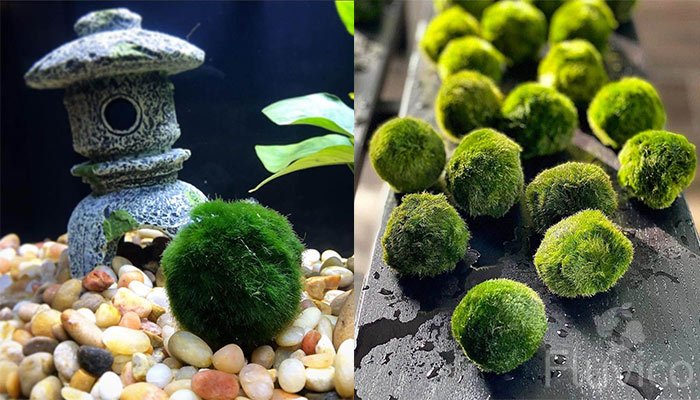
19. Marimo Moss Ball – Aegagropila linnaei
Marimo Moss Balls stand out thanks to their unique ball shape. They’re super low maintenance but also grow very slowly. Perfect if you’re looking for unusual addition plant for your tank.
While these green spheres look a lot like moss, they’re actually a type of algae that grows into a ball.
Suitable for both beginners, Marimo Moss Balls will also are only a net benefit to any aquarium setup.
If you have shrimp, you can’t get a better photo than them grazing on top of one of these cute green balls!
Full Care Guide: Marimo Moss Ball
- Size: Can grow up to 5 inches in diameter.
- Growth Speed: Slow.
- Light Levels Needed: Low to moderate.
- Ideal Water Parameters: pH 6.0 – 8.0; temperature 4°C to 24°C (39°F – 75°F).
- Difficulty Level: Very easy.
- CO2 and Fertilization Requirements: None.
- Propagation: Can be propagated by dividing into smaller pieces.
- Origins: Found in lakes in the Northern Hemisphere, including Iceland, Japan, and parts of Europe.
Thanks for checking out some of the most popular aquatic plants, mosses! Now we’ll take a look at why you might not want to add these cure aquatic plants to your next aquarium tank.
FAQs & Tips
4 Reasons to avoid adding Moss to your aquarium
While the idea of adding moss to your aquarium seems like a no-brainer. Like anything else in life, there are some potential downsides.
Here are some reasons why you might want to skip them all together and go with some of these other great aquarium plant options.
1. Invasive Fast Growth:
- Aquatic mosses, particularly fast-growing varieties like Java Moss, can become invasive in a tank. They have a tendency to spread quickly and can soon engulf your aquarium if not kept in check. This uncontrolled growth can smother other plants, compromise your aquascape aesthetics, and even impact equipment function if it gets too far out of hand.
2. Cleaning Difficulty:
- Mosses tend to attract and trap debris within their dense growth. This can make cleaning your tank a bit more challenging, as detritus can get stuck within the tendrils and contribute to a decline in water quality. This means more work on your part in terms of tank maintenance.
3. Difficulty in Removal:
- Once moss has attached to surfaces in your tank, it can be challenging to remove. Small pieces can easily get left behind and grow back, which might not be ideal if you decide to change your aquascape later on.
4. Susceptibility to Algae Growth:
- Mosses, especially those kept in high-light conditions, can sometimes become a hotbed for unwanted algae growth. The structure of moss provides an ideal surface for algae to attach to and proliferate, which can be a real eyesore.
11 Common Problems with Aquarium Moss (FAQs & Solutions)
1. Algae on Moss?
Algae growth on moss is often a sign of excessive nutrients or light. Reduce the intensity or duration of lighting, and consider incorporating algae-eating creatures or using an aquarium-safe algaecide. Regular water changes can also help reduce excess nutrients.
2. Moss Turning Brown?
Browning moss can be due to insufficient lighting or poor water conditions. Make sure your moss is getting enough (but not too much) light and check your water parameters. If necessary, adjust the lighting, temperature, and water chemistry accordingly.
3. Moss Won’t Stay Attached to Hardscape?
This is a common issue when moss is newly introduced to an aquarium. Using aquarium-safe glue or thread to attach it can solve the problem. Over time, the moss will naturally adhere to the hardscape.
4. Can Aquarium Moss Grow Out of the Water?
Yes, most types of aquarium moss can grow emersed, i.e., partially out of the water. They will, however, need high humidity to prevent drying out.
5. Why is my Moss Floating Around the Tank?
This usually occurs if the moss hasn’t been properly secured to the substrate or hardscape. Make sure to tie or glue it down securely. Moss can also detach if fish or invertebrates disturb it.
6. Can Moss Cause a Change in My Water’s pH?
While moss, like any plant, can have a minor impact on water chemistry, it’s unlikely to cause significant pH changes in a well-maintained tank. Regularly monitor your water parameters to ensure they stay within the appropriate range.
7. Is Moss Suitable for a Brackish Aquarium?
Most moss species are freshwater plants and won’t tolerate brackish conditions. Research specific moss varieties suitable for brackish tanks, such as Vesicularia species.
8. Can Moss Overgrow and Crowd Out Other Plants?
Some moss species can be quite aggressive in their growth. Regular trimming can keep them in check and prevent them from overshadowing or crowding out other plants.
9. Can I Use Moss from the Wild in My Aquarium?
While it’s possible, it’s generally not recommended due to the risk of introducing diseases, pests, and unknown contaminants into your aquarium. Always use moss from a reputable source.
10. Is Moss Beneficial for Fry and Shrimp?
Yes, moss provides excellent cover and a foraging area for fry and shrimp. It can also capture smaller food particles that these creatures can feed on turning them into a mossy buffet for your favourite shrimp.
11. Can Moss Help with Algae Control?
Yes, to some extent. Moss can absorb excess nutrients in the water, which can help reduce algae growth. However, moss alone may not be enough to control a serious algae problem.
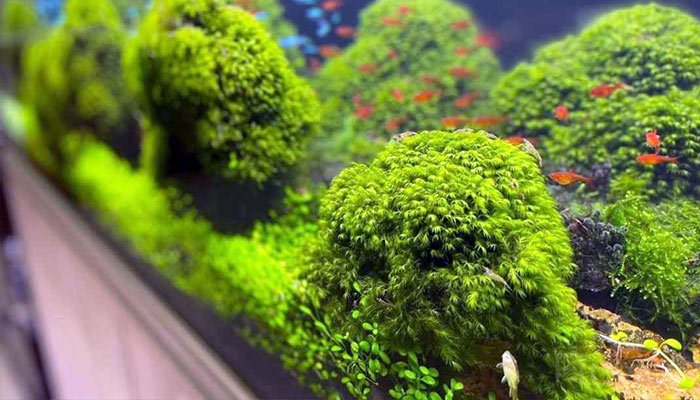
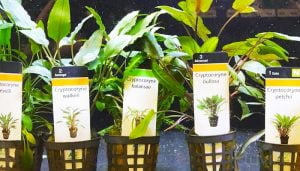
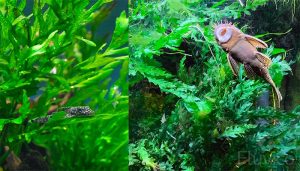
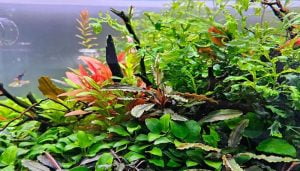


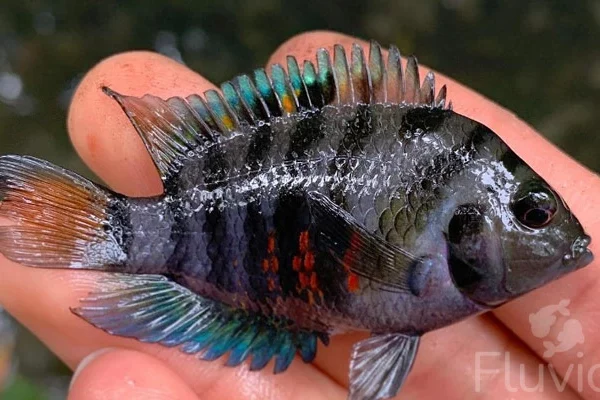
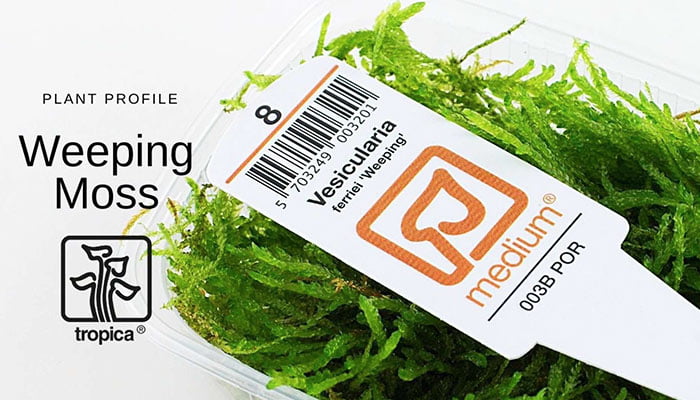
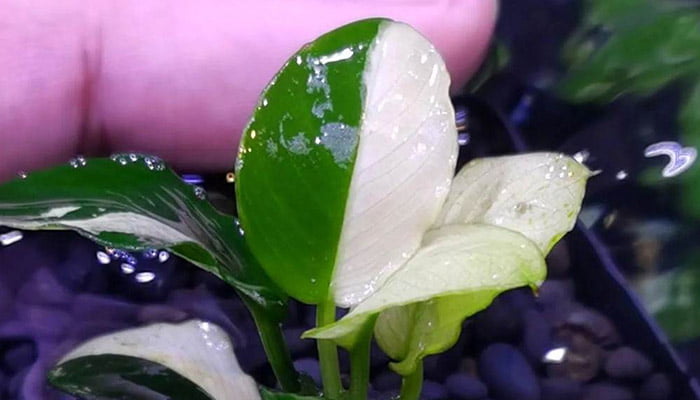

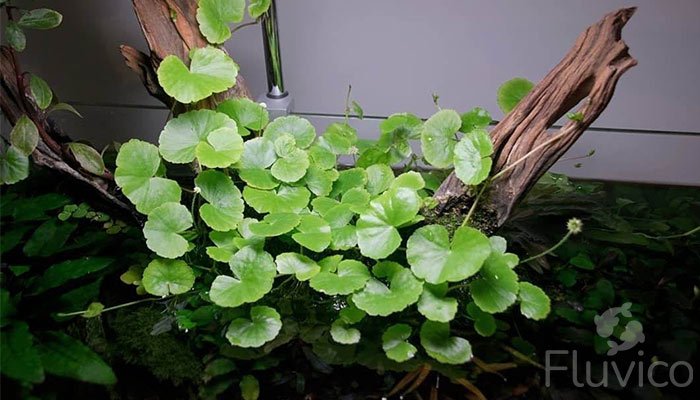
I hope you enjoyed this Aquarium Moss roundup and it gave you some ideas for your aquarium! As always, if you have any questions, just let us know : )